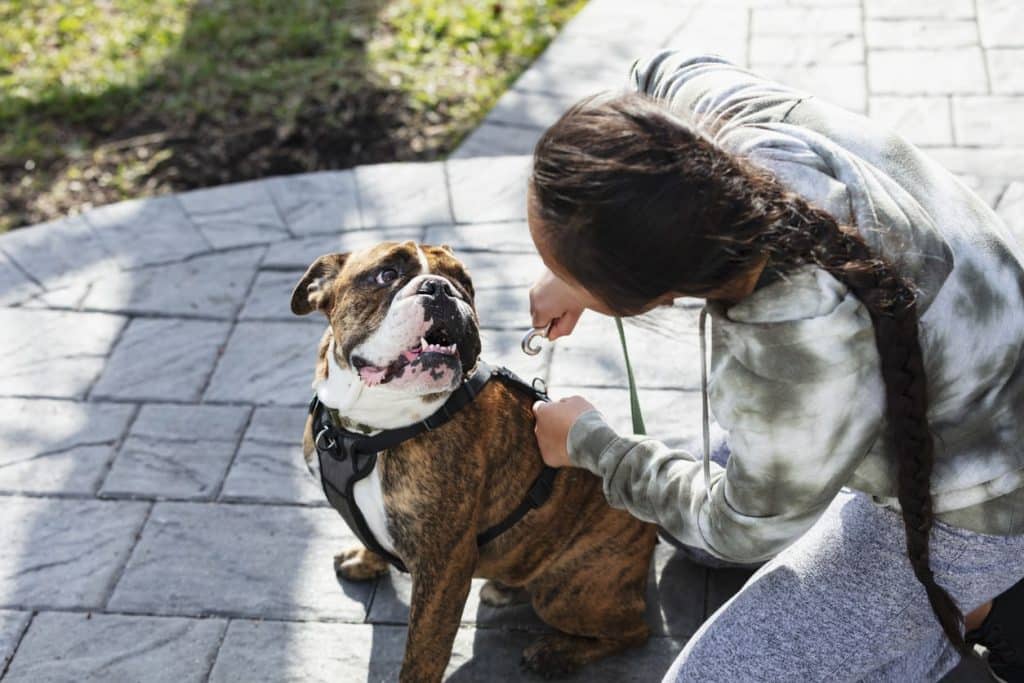Going for a walk is the highlight of the day for many pups. It’s a chance to explore, work off excess energy, and spend time with their beloved human. If your dog normally loves their daily jaunt but suddenly refuses to walk, it’s understandable to be a little confused, frustrated, or concerned.
Sometimes, a stubborn dog refuses to walk due to physical factors, such as discomfort, pain, or illness. Others might take issue with an element of the environment, such as the pace or direction of your walk. Getting to the bottom of your dog’s refusal is key, and often there’s a quick fix. But if there’s something serious going on, early intervention is crucial.
We spoke with veterinarians and animal behaviourists to learn what causes walk resistance and how to walk a dog that refuses to cooperate. Below, you’ll find simple solutions, along with things to avoid that could make matters worse.
Causes
According to Dr. Nita Vasudevan, a veterinarian at Embrace Pet Insurance, there are many reasons a dog might refuse to walk on a lead. The first step in correcting the problem, she says, is to figure out if your dog’s resistance is motivated by physical, behavioural, or environmental factors.
Here are some of the most common reasons a dog might refuse to walk.
Pain
If your dog seems uncomfortable when refusing to walk, there’s a good chance they’re in pain. Dr. Sabrina Kong, a licensed vet and dog trainer with We Love Doodles, says injuries or health issues can discourage a dog from walking. Bone and joint problems like osteoarthritis and hip dysplasia are especially common.
Pain isn’t something you should ignore. Cut the walk short and make an appointment with your veterinarian. Signs of pain may include changes in gait or posture, stiff movements, unusual breathing, shivering or shaking, and licking or biting a specific area of the body.
Discomfort
Milder than pain, discomfort can make a dog stop during a walk or refuse to go out entirely. Dr. Vasudevan says common sources of discomfort are a dog’s harness being too tight or their lead being too short. New walking gear that your dog isn’t yet comfortable with also might cause them to check at the door.
Medical concerns can still be a comfort factor as well, even if they don’t make walking outright painful for your pup. “Respiratory or cardiac conditions may cause fatigue,” says Dr. Vasudevan, which could make walking difficult or uncomfortable. Dogs who are overweight or obese may also struggle to walk beyond a certain distance.
Fear
If your dog suddenly refuses to walk even though they usually enjoy it, or if they refuse to walk in a particular direction, it could be due to fear or memory of a negative experience. Lillian Ciardelli, an Associate Certified Applied Behaviour Analyst with Behave Atlanta, says dogs can internalise fear of a painful or stressful event.
Fear-based refusal to walk could even be linked to a single traumatic event. For example, if your dog got into a fight with another dog, they might be hesitant to take that route again. Or if a car backfires during a walk and scares your dog, they might want to avoid the street on which it occurred in the future.
Lack of training
“Lack of familiarity with a lead, harness, or walking etiquette could lead to resistance,” says Dr. Vasudevan. Walking on a lead isn’t natural for dogs, and it can even be a little scary at first. This is often the case for puppies who refuse to walk and for untrained adult rescue dogs.
Temperature or weather
The weather can also impact your dog walk. Many dogs don’t like going outside when it’s cold. That goes double for breeds with thin coats, including Greyhounds and Beagles, and small breeds like Chihuahuas. Senior dogs, especially, can find cold exacerbates joint issues, while other dogs take exception to rain or snow.
Hot weather can also be a turn-off. If your dog seems excited to go on a walk but loses steam partway through, heat might be to blame. It’s important to recognise the signs of heat stroke so you can avoid putting your dog at risk.

iStock/kali9
Solutions
“Occasionally skipping a walk is fine,” says Dr. Vasudevan, “especially if your dog shows signs of stress or discomfort.” But it’s still important to identify the reason they’re refusing to walk—and to find an appropriate solution.
Here’s how to solve for the physical, behavioural, and environmental factors that may cause a dog to refuse to walk.
Physical factors
If walking causes your dog pain, it’s best to consult your vet right away. They might recommend rest, pain medication, or even hydrotherapy. If your vet prescribes a temporary break from walking, gentle forms of exercise like puzzle toys can help keep your pup mentally stimulated.
If the issue is discomfort rather than pain, your walking gear is a good place to start. “Experiment with different gear, such as a comfortable harness,” says Dr. Vasudevan, “to see if discomfort is the issue.” You might need to adjust the fit on your dog’s harness or buy booties in a different size.
Behavioural factors
Fear, unfamiliarity, and negative associations can all contribute to a dog’s refusal to walk. Dr. Vasudevan recommends positive reinforcement training to help.
For dogs who are afraid to go on walks, she says, “Start with short walks in quiet, familiar areas to build confidence.” Offer plenty of praise and treats to help your dog develop positive associations with walking. If your dog is afraid of a specific experience or route, you may need to slowly desensitise them to whatever is triggering their fear response. A professional trainer can help.
Environmental factors
You can’t control the weather, but intentionally choosing when to walk may reduce your dog’s resistance to it. “Always walk at cooler times of day to avoid weather-related aversions,” says Dr. Vasudeven. In the summer, that may mean early morning walks or waiting until the sun starts to set.
If your dog dislikes walking in the cold, try putting them in a dog coat or jumper. A set of booties can make walking on cold pavement more comfortable, and paw wax helps protect your pup from harmful de-icing chemicals. You can always stick to shorter walks in the winter and opt for indoor exercise when temperatures drop below freezing.

iStock/fotografixx
What Not To Do
Dealing with a dog who refuses to walk can be frustrating, especially if you’re already in the middle of a walk. The ideal solution in any given situation may not be immediately obvious. But there are a few things you definitely want to avoid doing at the risk of making things worse for both you and your dog.
Don’t yell at your dog
Yelling only makes the situation more confusing, stressful, and potentially scary for your dog. They might not even understand what you’re yelling about. Repeated occurrences could eventually damage the bond you have with your dog and contribute to other behavioural issues in the future.
Don’t drag your dog
A light tug on the lead to get your dog’s attention is okay, but never drag your dog. It might seem like a logical thing to do when your dog refuses to walk—like if you can just get them moving again momentum will then take over. But you could accidentally hurt your dog or cause them undue stress, besides teaching bad habits.
Don’t force your dog in the direction they’re scared of
You can’t explain to your dog the concept of conquering their fears, so forcing them to walk toward something they’re frightened of may only serve to reinforce that fear. Having negative experiences on walks might make your dog more resistant to them in the future. Your dog might even start to mistrust you if they no longer see you as a protective figure.
When do treats not work?
In some cases, a dog who refuses to walk might just need a little encouragement. If they’re not used to wearing a harness or walking in an unfamiliar area, for example, offering treats can help your dog form a positive association with the experience. But even the tastiest of treats can’t overcome pain or illness.
If your dog usually responds to edible encouragement but it stops working, it’s time to talk to your veterinarian.
Tips for Next Time
You shouldn’t force your dog to do something they don’t want to do—but neither should you give up on walking them entirely. After all, daily activity is essential for keeping your dog fit and healthy.
If your dog refuses to walk regularly and your vet has ruled out pain or illness, try making adjustments to your walking routine. Here are some ideas.
Try some new gear
If your dog is refusing to walk because they don’t like their lead or harness, try out some new gear. Dogs who feel constrained by a vest-style harness, for example, might prefer a step-in harness or a gentle leader. Don’t be afraid to experiment with different lead lengths and weights.
Switch up your route
Some dogs prefer a predictable routine, while others are more adventurous. A dog who refuses to walk in certain directions might see or smell something they want to explore elsewhere. Try taking a different route, visiting a park, or driving to another neighbourhood to walk to keep things interesting for your dog.
Let your dog guide the walk
Walks are great for exercise, but that’s not the only way they benefit your dog. A long walk offers an opportunity for your dog to engage all of their senses. If your dog doesn’t want to walk for the sake of walking, try letting them lead the way. Let them sniff to their heart’s content!
Walk a little faster
On the opposite end of the spectrum from dogs who like walks for mental stimulation are those who just like to get moving. If you feel like your dog is bored on walks, try picking up the pace to make it a little more challenging. You could even train them to run with you.
When should you get help?
Dr. Vasudevan says, “It may be time to seek veterinary help if there is a consistent refusal to walk.” If your dog doesn’t respond to gentle encouragement or the tips recommended above, there might be something wrong.
“Signs of pain, such as limping, whining, or unusual postures or sudden changes in behaviour,” says Dr. Vasudevan, should always be brought to your veterinarian’s attention.
Behavioural resistance, on the other hand, may be better addressed by an animal behaviourist or certified dog trainer.



